Between 1960 and 1980, aluminum wire was used extensively in residential building applications as a cheaper option than copper. Although the physical wire itself that runs through your walls and ceilings is safe, the termination points are not maintained, serious fire hazards can develop as aluminum termination points can loosen over time and the potential for arcing can exist. Birnie HomeSAFE can check these terminations to make sure they're tight, safe and eliminate the risk of fire.
Do you have Aluminum Wiring in your home?

Read Article on Aluminum Wiring
by Electrical Safety Authority
Is aluminum wiring dangerous?
FACT: Homes that have aluminum wiring are 55 times more likely to reach fire conditions than homes wired with copper.
Aluminum wiring can be dangerous if not properly maintained. Aluminum wire and any aluminum/copper wiring mix needs regular maintenance to ensure it has not oxidized and the connections have not deteriorated over time. Connecting, terminating and or combining copper and aluminum wiring together without the proper procedures will cause a fire. Bottom line if you suspect that you have aluminum wiring in your home your wiring needs to be checked.
Remember you need a healthy electrical system to power all the electronics in your home, but like anything it must be maintained. Let Birnie HomeSAFE inspect and maintain your homes aluminum wiring system, its the right and safe thing to do.
What are the issues with aluminum wiring?
Reported problems with aluminum wiring are related to the failure of the terminations due to overheating. Overheating is typically caused by the aluminum’s tendency to oxidize and its incompatibility with wiring devices that are not rated for aluminum wiring. It also has a high degree of thermal expansion, meaning that it swells when it’s hot and contracts when it’s cool. This expansion and contraction at the termination point can cause it to loosen up over time. Both the thermal expansion and oxidization result in higher resistance and higher resistance, which results in increased heat.
The first step is knowing if you have aluminum wiring. You can sometimes identify the wire type by looking at the insulation of the wires at the panel or by taking off a cover plate and looking into the box of a wiring device within the home. Always consult a licensed electrical contractor before tampering with your electrical wiring.
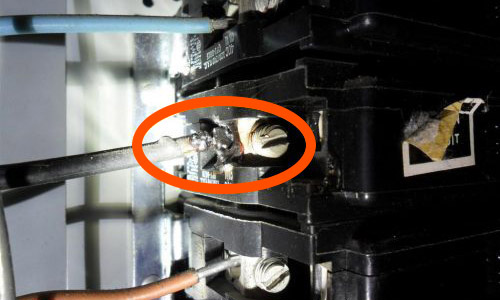
Never terminate copper and aluminum unless you use copper-aluminum termination compound to prevent oxidation. If you don't a fire hazard will develop over time.
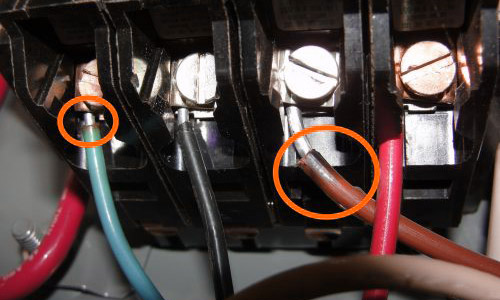
Scorched aluminum wiring under terminal
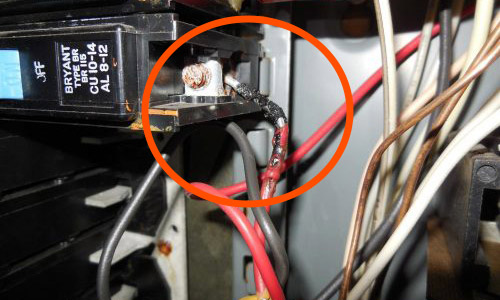
Burnt aluminum wiring during inspection
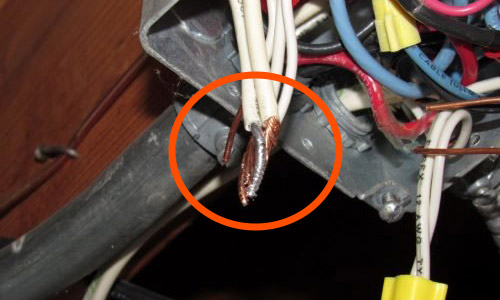
Never mix aluminum with copper.
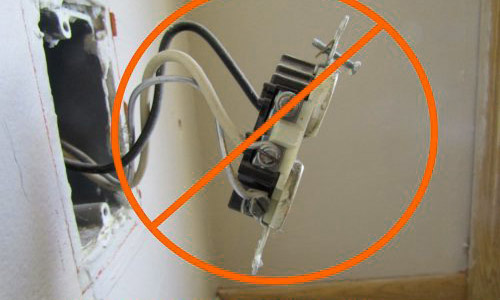
Home inspectors do not pull outlets. We do.
If your aluminum wiring looks like this, call us immediately!
CLICK HERE TO GET A QUOTESome of the common warning signs that you have failing aluminum terminators are:
Warm receptacles, switches, or cover plates
Discolouration of receptacles, switches, or cover plates
Flickering lights
The smell of burning plastic
Dispelling any myths about aluminum wiring and the steps necessary to ensure your safety:
The most common misconception is that you need to completely remove the wiring from behind the walls of your home and replace it with copper. Again, there are no issues with the integrity of the wire itself. Where we see the majority of the issues is where the aluminum makes a termination or connection to a device. The second most common myth is that aluminum wiring was recalled and is no longer used for interior wiring. The fact is that the Ontario Electrical Safety Code permits the installation of aluminum so long as adequate precautions are taken with the terminating and splicing of the conductors.
If you have aluminum wiring and are looking to have the connection points at your devices treated or pig-tailed, call us today, and our electrical solution team will advise you on how to approach and remedy the termination points within you home. Your insurance may also be charging you a premium for living in a home with aluminum wiring. Only a licensed electrical contractor like HomeSAFE, in conjunction with the Electrical Safety Authority, can provide you with the necessary certificate, stating that the work has been completed to satisfy code and best safety practices.
How does HomeSAFE repair aluminum wiring?
At HomeSAFE, we have a 3-step process to ensure your house is safe and your insurance is satisfied with the work completed.
A technician is sent to your house for a 4-hour mini assessment. He takes a look at the connections and gets a comprehensive list of issues sent back to the office for pricing.
Once the quote for the work is approved, a permit is pulled from the Electrical Safety Authority. Then, we make all necessary repairs to all aluminum connections within the home.
Once the work is complete, an inspection is performed by the Electrical Safety Authority. Once the work has passed inspection, a certificate from the ESA, along with a certificate from HomeSAFE, is sent to you in the mail. These documents will assist in reductions for your annual insurance premiums.
